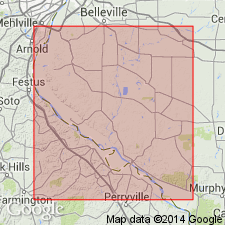
- Usage in publication:
-
- Baldwin formation
- Modifications:
-
- Original reference
- Dominant lithology:
-
- Sand
- Shale
- Limestone
- AAPG geologic province:
-
- Illinois basin
Summary:
Pg. 10 (fig. 2), 12, 13; J.M. Weller and A.H. Sutton, 1940, AAPG Bull., v. 24, no. 5, p. 837. Baldwin formation. Name proposed for strata formerly known as upper Okaw or Plum Creek beds. Consists of more or less sandy beds at bottom and top separated by shale and dark-gray somewhat cherty limestone; these three parts are equivalent to Tar Springs, Vienna, and Waltersburg formations of southern Illinois, but the sandstones are erratically developed and it is impractical to map them separately. Thickness 60 to 75 feet. Conformably underlies Menard limestone; locally overlies Okaw limestone unconformably and rests on different members of it in different places. Age is Late Mississippian (Chester).
Named from town on east side of Kaskaskia River in Randolph Co., southwestern IL. Outcrops extend from near Baldwin to Fort George and thence along Missisippi bluff to mouth of Marys River.
Source: US geologic names lexicon (USGS Bull. 1200, p. 203).
For more information, please contact Nancy Stamm, Geologic Names Committee Secretary.
Asterisk (*) indicates published by U.S. Geological Survey authors.
"No current usage" (†) implies that a name has been abandoned or has fallen into disuse. Former usage and, if known, replacement name given in parentheses ( ).
Slash (/) indicates name conflicts with nomenclatural guidelines (CSN, 1933; ACSN, 1961, 1970; NACSN, 1983, 2005, 2021). May be explained within brackets ([ ]).

